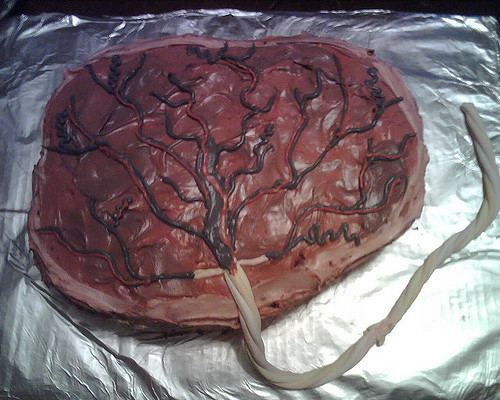Type Pie | Place of origin Roman Empire | |
 | ||
Main ingredients Flour and semolina dough, cheese, honey, bay leaves Similar Moretum, Neapolitans, Garum, Tiropita, Plăcintă | ||
Placenta is a dish from ancient Rome consisting of many dough layers interspersed with a mixture of cheese and honey and flavored with bay leaves, then baked and covered in honey. Cato included a recipe in his De Agri Cultura (160 BC). Cato writes:
Shape the placenta as follows: place a single row of tracta along the whole length of the base dough. This is then covered with the mixture [cheese and honey] from the mortar. Place another row of tracta on top and go on doing so until all the cheese and honey have been used up. Finish with a layer of tracta...place the placenta in the oven and put a preheated lid on top of it ... When ready, honey is poured over the placenta.
It derives from the Greek term plakous (Greek: "πλακοῦς", gen. "πλακοῦντος" – plakountos) for thin or layered flat breads, and Andrew Dalby considers it, and surrounding dessert recipes in Cato, to be in the "Greek tradition," possibly copied from a Greek cookbook. A flowery description of plakous was left by the Greek poet Antiphanes (fl. 3rd century BC).
A number of scholars suggest that the dessert's Eastern Roman (Byzantine) descendants, plakountas tetyromenous ("cheesy placenta") and koptoplakous (Byzantine Greek: κοπτοπλακοῦς), are the ancestors of modern tiropita (börek) and baklava respectively. The name placenta (Greek: "πλατσέντα") is used today on the island of Lesbos in Greece to describe a baklava-type dessert of layered pastry leaves containing crushed nuts that is baked and then covered in honey. Another variant of the Roman dish survived into the modern era as the Romanian plăcintă cake.
Through its Greek name plakountos, it was adopted into Armenian cuisine as plagindi, plagunda, and pghagund, all "cakes of bread and honey." From the latter term came the later Arabic name iflaghun, which is mentioned in the medieval Arab cookbook Wusla ila al-habib as a speciality of the Cilician Armenians settled in southern Asia Minor and settled in the neighboring Crusader kingdoms of northern Syria. Thus, the dish may have traveled to the Levant in the Middle Ages via the Armenians, many of whom migrated there after the first appearance of the Turkish tribes in medieval Anatolia.
